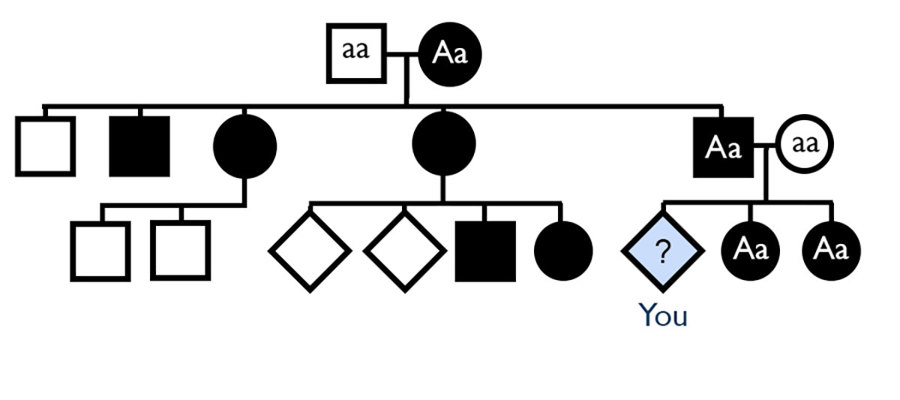
What are the chances of inheriting amelogenesis imperfecta?
October 25, 2004

A high school student from Trinidad and Tobago asks:
“Hi. Well my grandmother on my father’s side has amelogenesis imperfecta (that is where there is no enamel on the tooth). My father got it as well as his 2 sisters and one of his brothers. For one of his sisters, 2 out of 4 children got it; a girl and a boy. His other sis’s children did not get it and they are all boys, but all of my sisters have it. Would my children get this? What are the ratios of my kids getting it? Would you say it is a dominant allele? Especially for women than men?”
Editor’s note (6/02/2021): When this article was published, amelogenesis imperfecta was thought to only be inherited in an autosomal dominant manner. We now know that there are less common forms of this disease that are inherited in other ways.
I love these sorts of gene sleuthing questions! There are two types of amelogenesis imperfecta (AI). In one type, boys and girls have an equal chance of getting the dominant gene for AI. In the other, girls are more likely to get the dominant gene.
Since both types are dominant, the only way to inherit the disease is if at least one of your parents has it. If you do not have AI, then the only way for your kids to get it is if your future spouse has the disease.
So why is it that if the gene is dominant, you have to have the disease to pass it on?
To answer this question, we need to go a bit into some basic genetics. Remember, we all have two copies of each gene; one we get from our father and one from our mother. (An exception to this is the genes on the X and Y chromosomes, which we’ll discuss in more detail below.)
One of the ways we get lots of different people in the world is that genes sometimes come in different versions, called alleles. For each of the AI genes, there are two versions. One version gives you the disease and the other does not.
What if you get the AI version from your mom and the non-AI version from your dad? Do you get a mix, something like a less severe form of the disease, or does one version win out over the other?
As is usually the case with different versions of a gene, one version of the AI gene wins out – the version that gives you the disease. The copy of the gene that wins out is called the dominant version, the loser is called the recessive version.

One more thing and we can get to explaining your family. The way geneticists usually show dominant and recessive genes is by writing the dominant gene with a capital letter and the recessive gene with a lower case letter. For AI, the diseased tooth enamel version is dominant and so shown with an A, while the healthy enamel version is recessive and so is a.
Both AA and Aa people have AI, but only aa people have healthy tooth enamel. This means that for the AI genes, if you have at least one copy of a dominant AI gene, then you will have the disease. Unlike some other diseases like cystic fibrosis, for AI, the only way to pass on the disease is if one of the parents has the disease.
OK, so what about you and your family?
Your grandfather did not have AI, so his genes were aa. Your grandmother had AI, so she was Aa or AA. Your grandmother was probably Aa since some of her kids had the disease and others did not. Most of her children, including your father, got an A from her and an a from their father, so they had AI.
To try to make this more clear, I’ve done what geneticists love to do – make a family tree! A family tree, or pedigree, is a diagram that helps geneticists track who has a certain version of a gene. In a family tree, a circle stands for a woman, a square is man, and a diamond is someone whose sex we don’t know. The shapes colored black are the people who have the condition, in this case AI.

Your father passed his dominant AI gene (A) to your sisters and that is why they have AI. If you have AI, then you also got an A from your father. Remember, since your mother doesn’t have AI, she can only give her children the non-disease version, a. So, if you have AI, you must be Aa and your chances of passing it to your children are 50%. If you don’t have AI, then you got a’s from both your mother and father and your children will not have AI.
Think we’re all done? If only genes were that simple ... I mentioned earlier that there are two types of AI, one that everyone has the same chance of getting and one that girls have a greater chance of getting. This is because there are two genes that can cause AI: one on the X chromosome and one chromosome 4.
We all have two copies of chromosome 4, one from our mother and one from our father. But the X chromosome is different. Remember, women have two X chromosomes and men have an X and a Y chromosome. Women have two copies of the genes on the X chromosome and none of the genes on the Y chromosome. Men have one copy of each gene on the X and Y chromosomes.
So why do girls have a greater chance of getting AI when it is on the X chromosome? Girls get an X chromosome from dad and one from mom. Boys get an X only from their moms. If the father has AI, he can only pass down his one X chromosome, which will carry AI, to his daughter. However, a father will only pass down his Y chromosome to his sons, so they will not get the gene for AI that is on the X chromosome.
When a mother has AI, the chances are the same for all her children to have it because they will all get one of her X chromosomes. Now we’re ready to apply all of this information to your example. We know that AI in your family is dominant, but let’s find out if it’s on the X chromosome (X-linked) or not. Since you didn’t tell me if you’re a boy or a girl or if you have AI, let’s consider the possibilities in the table below. We’ll also see if it is X-linked and your chances of passing it down, assuming that your future spouse does not have it.
|
If you are a ... |
Is it X-linked? |
Chances of passing it to children |
|
Male with AI |
No. Your father has it, but did not give you his X chromosome and you still have it. It has to be on chromosome 4. |
All your children have a 50% chance of getting it, depending on which version of chromosome 4 they get from you. |
|
Male without AI |
Can't tell. You either didn’t get it because it's on the X chromosome, or you got the recessive version on chromosome 4. |
Children will not have it. |
|
Female with AI |
Can’t tell. You may have gotten it from your father's X chromosome or chromosome 4. |
All your children have a 50% chance of getting it, depending on which version of the X or chromosome 4 they get from you. |
|
Female without AI |
No. If it was on the X, you would have gotten it from your father since he can only give you an X chromosome with AI. |
Children will not have it. |
Well, those are all the possibilities. Now it’s your turn to be the geneticist and find out which one applies to you!

Author: Flo Pauli
When this answer was published in 2004, Flo was a Ph.D. candidate in the Department of Genetics, studying tissue-specific gene expression in c. elegans in Stuart Kim’s laboratory. Flo wrote this answer while participating in the Stanford at The Tech program.
 Skip Navigation
Skip Navigation
